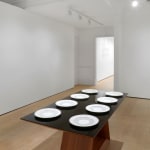Wilma WOOLF
Domestic, 2020
Set of 8 ceramic plates, each with hand-transferred text, and installed on a custom black glass-topped table
Each plate: 2.8 cm high x 32 cm in diameter
Table: 183 cm (length) x 91.5 cm (height)
Table: 183 cm (length) x 91.5 cm (height)
Edition 2 of 3 + 1 AP
Further images
-
(View a larger image of thumbnail 1
)

-
(View a larger image of thumbnail 2
)

-
(View a larger image of thumbnail 3
)

-
(View a larger image of thumbnail 4
)

-
(View a larger image of thumbnail 5
)

-
(View a larger image of thumbnail 6
)

-
(View a larger image of thumbnail 7
)

-
(View a larger image of thumbnail 8
)

-
(View a larger image of thumbnail 9
)

Domestic is an Installation documenting all the women that have been killed in the UK at the hands of male violence since 2013. Seven individual plates are placed on a...
Domestic is an Installation documenting all the women that have been killed in the UK at the hands of male violence since 2013. Seven individual plates are placed on a table, representing seven years of accurate data. On each plate is the year, the woman’s preferred name, her relationship to the person that killed her or her children, and how that woman died. Specifically designed icons create a visual language to communicate the cause of death.
The plates are laid on a black glass table. The glass is so dark that it acts as a mirror to the viewer peering over the table to the plates laid out. It is to reflect that domestic violence is both ageless and classless and can and does affect everyone.
The aim of this piece of work is dualistic. It is to remember the women who have needlessly lost their lives and also, to highlight the institutionalised and systemic acceptance of this human rights abuse often regarded as an inevitable part of men and women co-existing.
This piece of work allows the viewer to visualise and understand this crime as one continuous crime, not only a series of inevitable incidents. It allows us to see that protecting women’s lives is regarded as less important than a man’s right to exercise control and life ending violence.
There are a plethora of policy responses that could be enacted to help combat this crime. Funding for mental health support, sustained funding for safe houses, improved responses from police and associated agencies to protect women when they report this crime are a handful of examples.
The Femicide Census, published in 2020 stated: “there is little suggestion that any intervention over the past ten years has had a significant impact or even any impact at all on the number of women being killed by men.” This is an unacceptable failure when considering the devastating impact of this violence, compounded by the fact that it is known, through research, what policies can help combat and prevent this crime.
The research for this installation is based on data collected by the Counting Dead Women project and cross referenced with the Femicide Census where appropriate. The ceramic plates were printed at Heraldic Pottery, Staffordshire.
The plates are laid on a black glass table. The glass is so dark that it acts as a mirror to the viewer peering over the table to the plates laid out. It is to reflect that domestic violence is both ageless and classless and can and does affect everyone.
The aim of this piece of work is dualistic. It is to remember the women who have needlessly lost their lives and also, to highlight the institutionalised and systemic acceptance of this human rights abuse often regarded as an inevitable part of men and women co-existing.
This piece of work allows the viewer to visualise and understand this crime as one continuous crime, not only a series of inevitable incidents. It allows us to see that protecting women’s lives is regarded as less important than a man’s right to exercise control and life ending violence.
There are a plethora of policy responses that could be enacted to help combat this crime. Funding for mental health support, sustained funding for safe houses, improved responses from police and associated agencies to protect women when they report this crime are a handful of examples.
The Femicide Census, published in 2020 stated: “there is little suggestion that any intervention over the past ten years has had a significant impact or even any impact at all on the number of women being killed by men.” This is an unacceptable failure when considering the devastating impact of this violence, compounded by the fact that it is known, through research, what policies can help combat and prevent this crime.
The research for this installation is based on data collected by the Counting Dead Women project and cross referenced with the Femicide Census where appropriate. The ceramic plates were printed at Heraldic Pottery, Staffordshire.
Exhibitions
Wilma Woolf: Domestic, Jubilee Room, Houses of Parliament, by invitation of Jess Phillips MP, 2022Wilma Woolf: Domestic, Richard Saltoun Gallery London, 2021
Join our mailing list
* denotes required fields
We will process the personal data you have supplied to communicate with you in accordance with our Privacy Policy. You can unsubscribe or change your preferences at any time by clicking the link in our emails.








